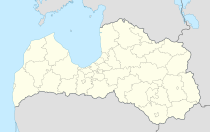Talsi
| Talsi ( German : Talsen) | ||
|---|---|---|
 |
|
|
| Basic data | ||
| State : |
|
|
| Landscape: | Courland ( Latvian : Kurzeme ) | |
| Administrative district : | Talsu novads | |
| Coordinates : | 57 ° 15 ' N , 22 ° 35' E | |
| Residents : | 10,377 (Jan. 1, 2016) | |
| Area : | 7.8 km² | |
| Population density : | 1,330 inhabitants per km² | |
| Height : | ||
| City law: | since 1917 | |
| Website: | www.talsi.lv | |
| Post Code: | ||
| ISO code: | ||
| View of Talsi | ||
Talsi (German: Talsen , Liv : TALSA ) is a city in western Latvia , in the region of Courland (Latvian: Kurzeme ). She likes to call herself the “Pearl of Courland” or the “City of Nine Hills”. In 2016 Talsi had 10,377 inhabitants.
history
The place was populated by Lives in the 10th century and later by cures . Talsi (villa Talse) first appeared in a document in 1231 as part of the Baltic Crusades. In 1422 a settlement near the castle hill is mentioned (pilsahten to Talsen) and in 1434 a castle of the Livonian Order . From this time on, German craftsmen and traders also settled near the castle. From 1609 a brick church existed.
In the 16th century the place was a small market town in the Duchy of Courland , whose economy was mainly based on iron extraction . Talsi was hit by two plague epidemics (1657 and 1710 ). In 1710 ten people are said to have lived here. In 1733 the city was destroyed by a major fire.
After Courland came to the Russian Empire in 1795 , many Polish-Lithuanian Jews settled there. Later they made up more than half of the population and dominated the city's trade.
In the 19th century, literacy began and the first Russian and German-speaking schools were established. The city was the center of the Hauptmannschaft Talsen in 1819 and received limited city rights in 1894 . There were factories for matches, liqueurs and wool, as well as a brewery and a printing plant. During the Russian Revolution of 1905 , power passed to the revolutionary committees in December before the Tsarist punitive expedition arrived.
During the First World War , Talsi was granted town charter under German occupation in 1917. As a result of the forced evacuation, the city had little more than 4,000 inhabitants at that time, 12% of whom were Jews (see Synagogue (Talsi) ).
With Latvian independence, an economic upswing began. There was also a small town cultural life; the city was a transit point for traveling theater until the Second World War . In 1939, as a result of the stationing agreement, the Red Army began building an airfield near Talsi, before all of Latvia was occupied in 1940.
During the German-Soviet War, Talsi was occupied by the Wehrmacht from July 1, 1941 until the German surrender. In 1945 the headquarters of the Kurland Army Group was in Talsi. The majority of the local Jews were deported and killed during the war years.
In 1965 the Latvian SSR decided to build an iron smelting plant in Talsi . At its peak, the factory employed more than 350 workers and exported its products to the entire Soviet Union and even to Great Britain and the Mongolian People's Republic . The new wealth made it possible to implement a new development plan that included a cinema, a hotel, the administrative center and a parking garage, and several parks were created in the city.
Talsi is currently benefiting from the growth of the service sector in most of the main towns in the region and from the increase in tourism in Courland.
Talsu novads
The Talsi district (Talsu novads) has existed since 2009, and most of the municipalities of the former district joined it. In 2010, 34,443 inhabitants lived in the four cities and 14 rural communities of the district (see: Administrative divisions of Latvia ).
Over 95% of the population describe themselves as Latvians . Russians are the largest of the 22 minorities.
Personalities
Sons and daughters of the place
- Arta Dumpe (* 1933), sculptor
- Vera Zozuļa (* 1956), luge athlete
- Uvis Helmanis (* 1972), basketball player
- Romāns Vainšteins (* 1973), racing cyclist
- Madara Palameika (* 1987), javelin thrower
- Janis Strelnieks (* 1989), basketball player
Connected to Talsi
- Carl Amenda (1771–1836), Beethoven's friend , pastor in Talsi from 1802 to 1836
literature
- Hans Feldmann , Heinz von zur Mühlen (ed.): Baltic historical local dictionary, part 2: Latvia (southern Livonia and Courland). Böhlau, Cologne 1990, ISBN 3-412-06889-6 , pp. 634-635.
- Astrīda Iltnere (ed.): Latvijas Pagasti, Enciklopēdija. Preses Nams, Riga 2002, ISBN 9984-00-436-8 .
- Sigurds Rusmanis, Ivars Vīks: Kurzeme . Izdevniecība Latvijas Enciklopēdija, Riga 1993, ISBN 5-89960-030-6 , pp. 140-147.


